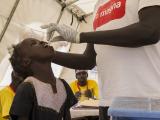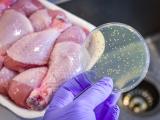Jun 19, 2007 (CIDRAP News) – A series of illness outbreaks linked to tomatoes over the last decade prompted the US Food and Drug Administration (FDA) to announce last week an initiative to explore contamination causes and develop better guidance to reduce the number of tomato-related illnesses.
Over the past 10 years, fresh tomatoes have been linked to 12 outbreaks that resulted in 1,840 confirmed illnesses, according to a Jun 12 press release from the FDA. Most of outbreaks, including two last summer and fall, involved Salmonella.
The FDA traced most of the outbreaks to tomatoes from Florida and the eastern shore of Virginia, though some of the contaminated products also came from California, Georgia, Ohio, and South Carolina, the press release said.
The FDA said its investigators would collaborate with health and agriculture officials in Florida and Virginia to identify practices or conditions at tomato farms and packing facilities that lead to contamination. The initiative will begin during this year's growing season, focusing on Virginia in the summer and Florida in the fall.
During the environmental part of the investigation, officials will be examining irrigation water, wells, chemical mixing procedures, droughts and floods, and animal proximity to growing fields, the FDA said.
"Produce is an important part of a healthy diet, and FDA wants to improve its safety by better understanding the causes of foodborne illnesses and by promoting more effective methods of safe food production, delivery, and preparation, said Robert Brackett, PhD, director of the FDA's Center for Food Safety and Applied Nutrition, in the press release.
The findings of the investigation will not only help the FDA improve its tomato safety guidance and policy, but also suggest areas for further research, education, and outreach, the agency said. Several universities and members of the produce industry will be part of the safety initiative, which the FDA says complements the Leafy Greens Initiative that was launched in 2006 to explore factors that led to a spate of Escherichia coli outbreaks linked to lettuce and other leafy greens produced in California's Salinas Valley.
In 1990 and 1993, investigations of multistate salmonellosis outbreaks traced the cause to tomatoes processed at a single South Carolina tomato packer. The authors, who published their findings in a 1999 issue of Epidemiology and Infection, concluded that inadequately monitored chlorine levels in the processor's wash tanks likely contributed to the outbreaks.
Craig Hedberg, PhD, lead author of the study and a University of Minnesota expert on foodborne disease, said that despite investments that have been made to address tomato contamination problems over the past decade, little fundamental change has occurred. Hedberg said he hopes the FDA's current initiative will spur new measures to reduce the number of outbreaks linked to tomatoes.
In 2005, the US Centers for Disease Control and Prevention (CDC) published findings on three Salmonella outbreaks in the summer of 2004 that were linked to Roma tomatoes. The account said the tomatoes in all three outbreaks were traced to a single packing house in Florida, though other growers or packers also could have supplied contaminated products.
More research is needed to determine if Salmonella can travel from the roots to the fruit or if contaminated seeds can affect subsequent generations of tomato plants, the authors noted. "Understanding the mechanism of contamination and amplification of contamination of large volumes of tomatoes is critical to prevent large-scale, tomato-associated outbreaks," they wrote.
The authors pointed out that produce packing houses were exempt from Good Manufacturing Practices (GMP) requirements, though the FDA encouraged GMP controls for water used in the packing houses. "However, the extent to which FDA guidance has been adopted by the industry is unknown," the report said.
At a Mar 20 FDA hearing on regulatory options for fresh fruits and vegetables, Elisa Odabashian, director of the Consumers Union's West Coast office, asserted that the FDA's voluntary guidelines for producers have failed to make food safer, according to a copy of the prepared testimony. She said the only way to make food safer and rebuild consumer confidence is for the FDA and/or the California Department of Health Services to mandate Good Agricultural Practices for growers and Hazard Analysis/Critical Control Point (HACCP) systems for all processors.
See also:
Jun 12 FDA news release
http://www.fda.gov/NewsEvents/Newsroom/PressAnnouncements/2007/ucm108931.htm
CDC. Outbreaks of Salmonella infections associated with eating Roma tomatoes—United States and Canada, 2004. MMWR 2005 Apr 8;54(13):325-28 [Full text]
Hedberg CW, Angulo, FJ, White KE, et al. Outbreak of salmonellosis associated with eating uncooked tomatoes: implications for public health. Epidemiol Infect 1999;122(3)385-93 [Abstract]
Mar 20 Consumers Union testimony to the FDA
http://www.consumersunion.org/news/cu-tells-fda-mandatory-regulation-of-produce-industry-is-long-overdue/















